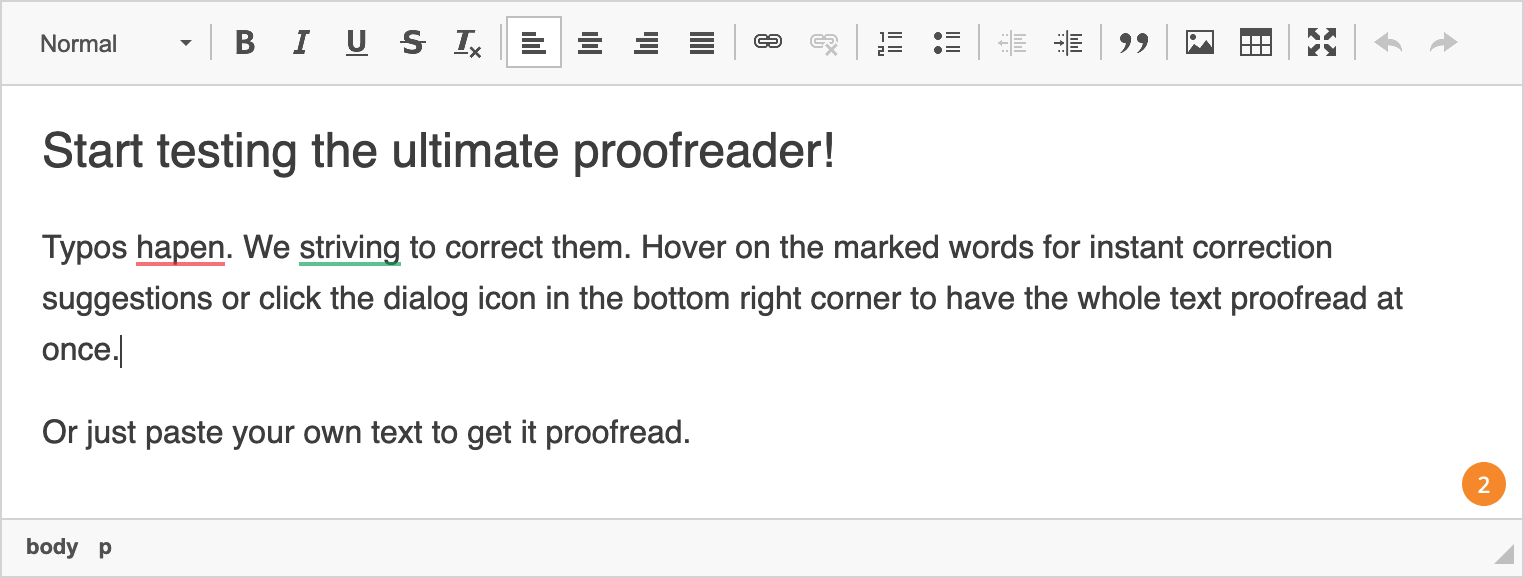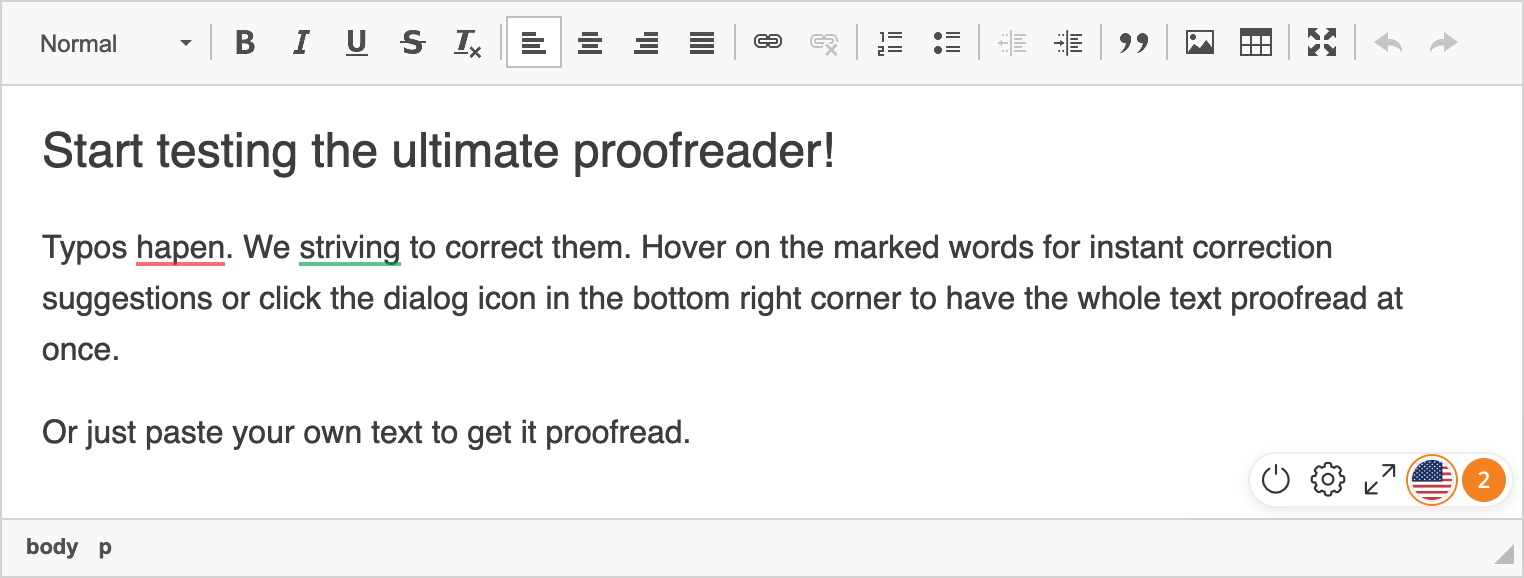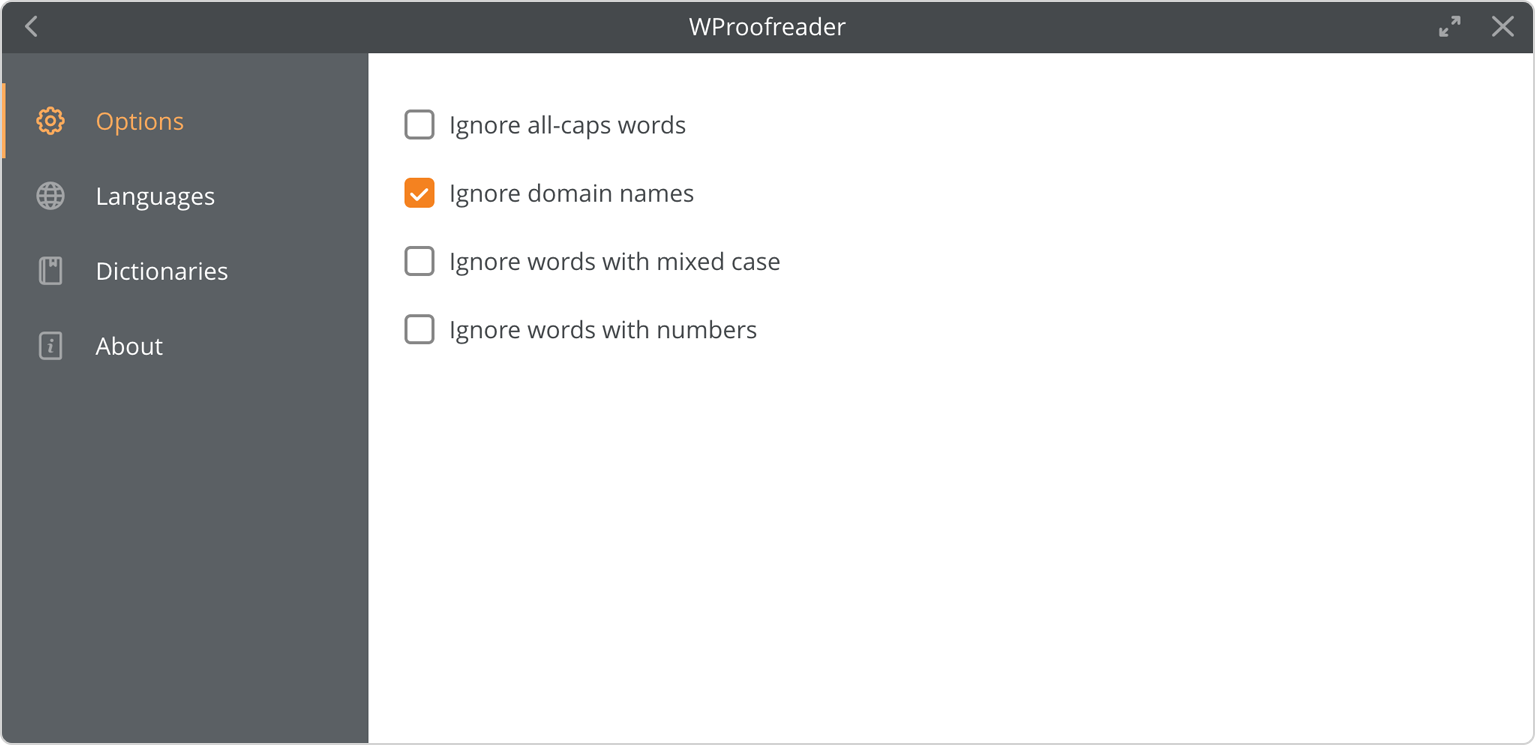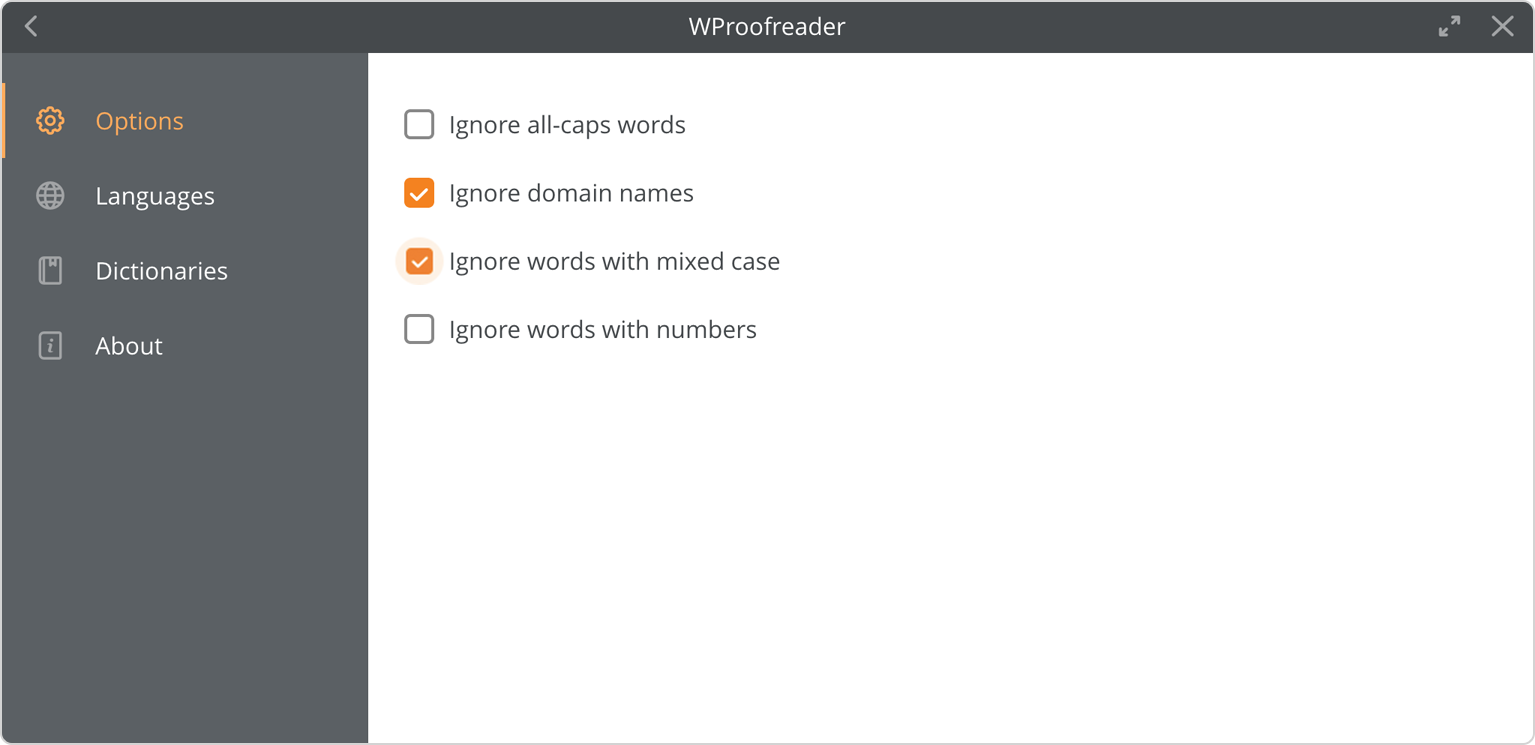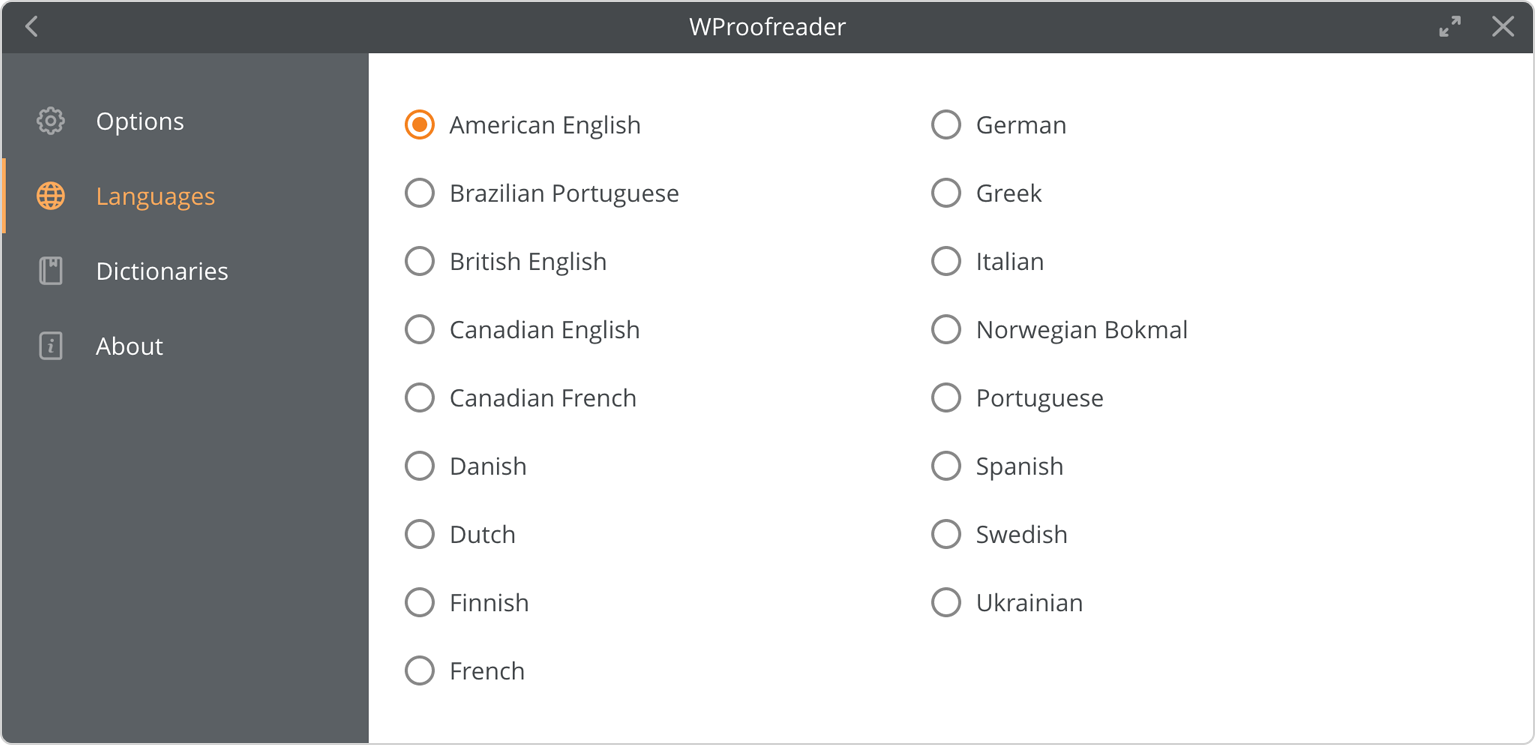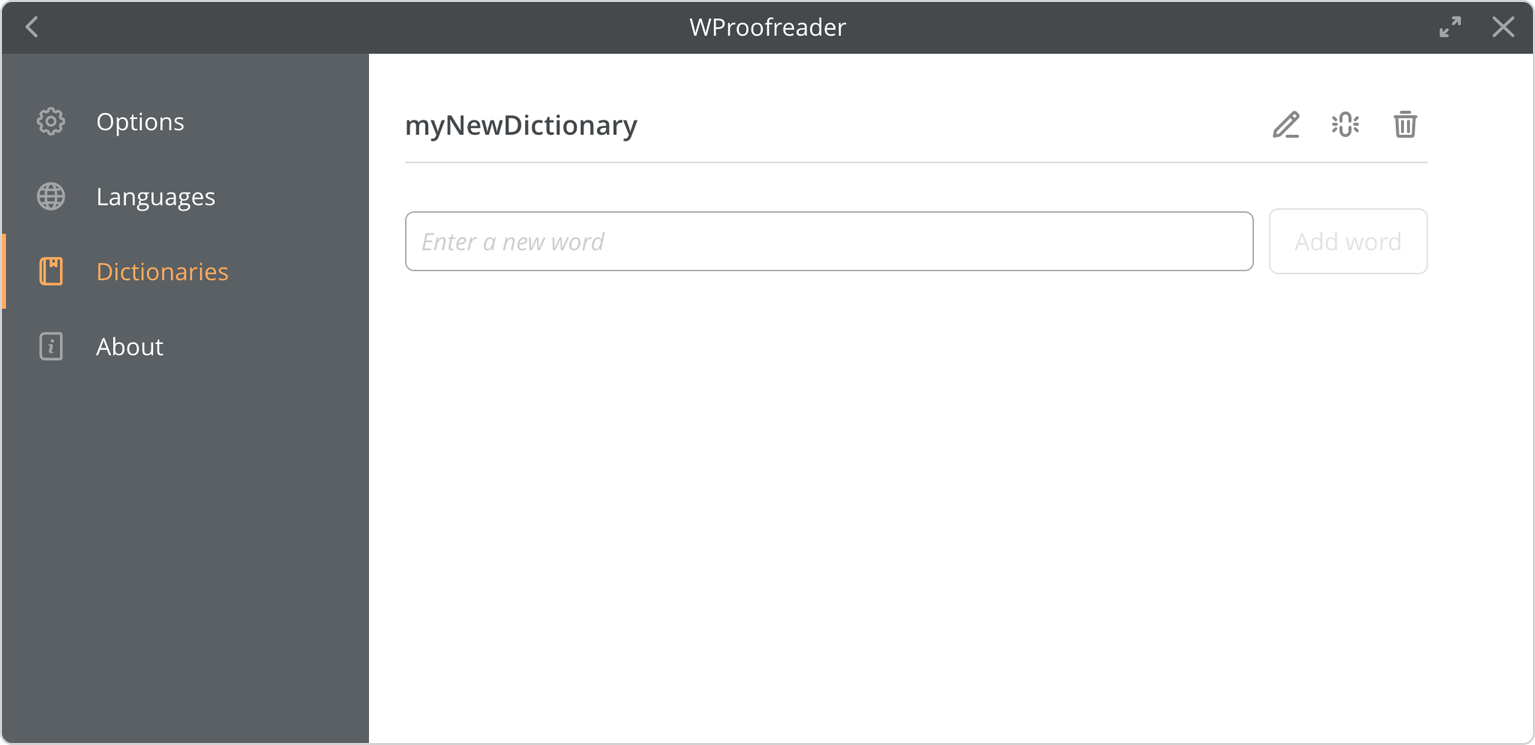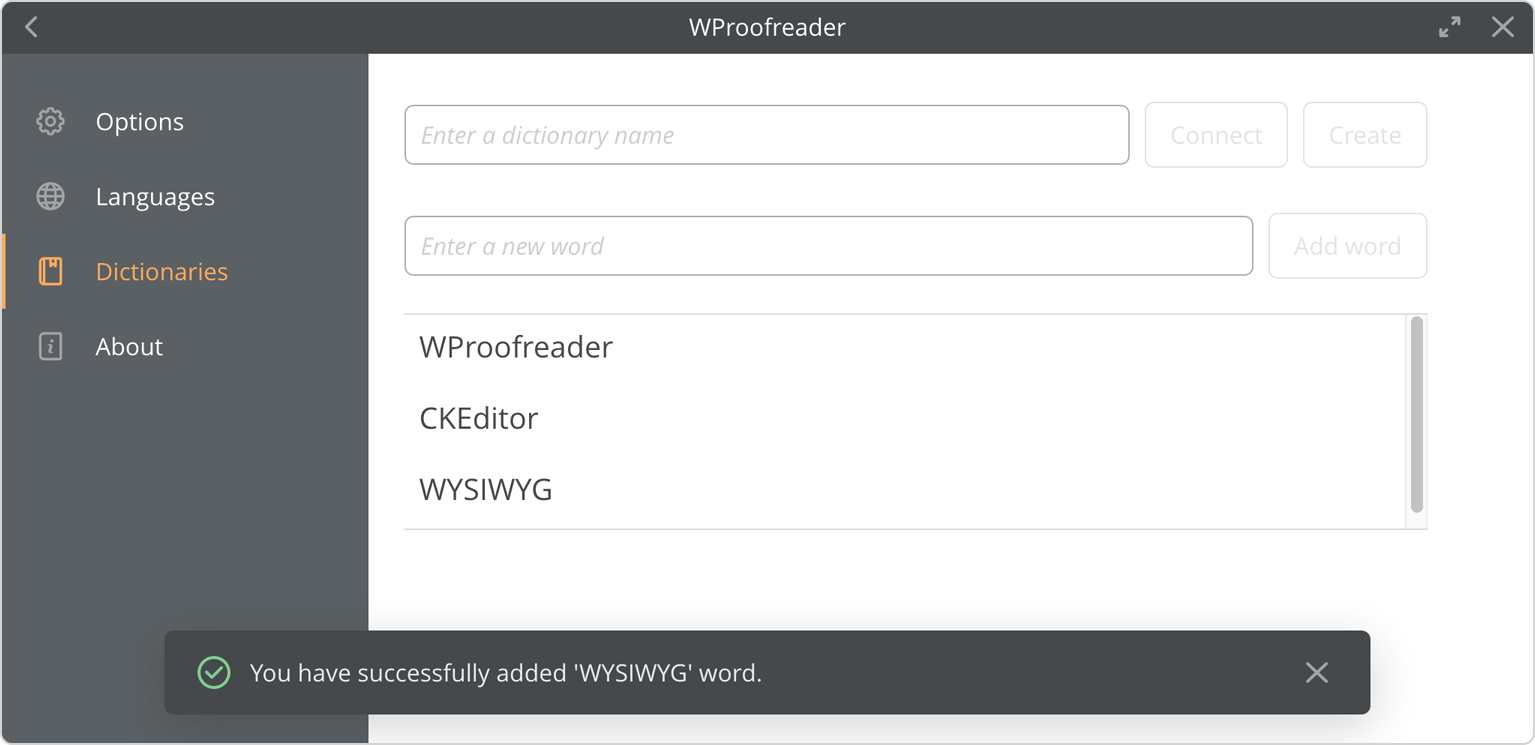WProofreader is a multilingual proofreading tool for web applications. It enables grammar and spell check combining spelling and grammar suggestions while you type or work with your text in a dedicated dialog. WProofreader meets the accessibility standards of the Web Content Accessibility Guidelines (WCAG), in particular WCAG 2.1, and also Section 508. Thus, all web application users, regardless of the limitations they might be facing, can access the main WProofreader features via a keyboard only, thus interacting with it can be more effective and easier. Below is an overview of the keyboard commands you can use to proofread your texts, navigate between the spelling and grammar suggestions, add words to a personal user dictionary, and customize WProofreader settings. This version of the guide describes the WProofreader user interface starting from version 2.3. As you type your text in a web app with integrated WProofreader, it tries to suggest grammar and spelling suggestions for you on-the-fly and shows the number of discovered issues in the badge in the lower-right part of the editor screen. If no spelling issues are found, the badge shows the tick sign inside. The total number of issues found is displayed in the badge. Accessing more features The badge in the lower-right part of the editable area shows the number of errors on page and allows to access more options: To access more commands and WProofreader dialog in as you type mode, navigate to the badge using Tab. As you navigate to the badge, a circle appears around the number of found issues. The badge button is in the focused state. Press Enter or Space to open the badge and access such options as Proofread in a dialog mode, Settings dialog or Disable/Enable WProofreader. The badge menu with the Settings icon highlighted. If enabled, there can be also a language selector icon present on the badge. The list of languages available can be open using Enter or Space. To confirm the selection of a language, use Enter or Space as well. On MacOS laptops, only Space can be used to open the list of languages. However, this depends a lot on the system preferences. The badge view with Language picker enabled. Use the commands in table below to access more WProofreader options. Select the Disable / Enable / Settings / Proofread in dialog / Languages mode. Exit the menu. To access Proofread in dialog from as you type dialog: Use the commands in table below to check your text, namely, view and accept or reject the grammar and spelling suggestions, and add words to a personal dictionary. Up/Down arrow key Navigate inside the suggestion area: When a problem is active, and you use Up or Down arrow keys, you can navigate to Add word and Ignore all buttons and add a word to a personal dictionary or ignore the issue respectively. The view of the Proofread in dialog mode. You can access and change WProofreader settings in the Settings dialog. To access this dialog from the as you type mode: The WProofreader badge. The Settings icon is selected. You can alternatively access Settings while proofreading your text in a dialog. To do so, press Tab continuously until you focus on the Settingsicon and it gets highlighted and then press Enter or Space. The WProofreader dialog. The Settings icon is selected in the top-left corner. To access and modify WProofreader options: Press the Tab key until the Options section is selected. Then press Enter or Space and again Tab to navigate to the options area. Use the Tab / Shift+Tab keys to navigate to the desired option and then press Space to select or deselect the desired option. The changes are applied automatically. The Settings dialog with the Options tab selected. Keyboard command Description Tab/Shift + Tab Move continuously across the Options tab settings. Enter/Space Open/select the menu group. To change the options of the selected Options dialog group, use the commands in table below. Switch through the options. Space Select or deselect the desired option. The Options tab. Ignore words with mixed case was selected. To specify the currently used language for proofreading (spelling and grammar check): The Languages tab is selected. Use the Dictionaries settings to create a new dictionary or connect an already existing one, and also add or remove the words from the dictionaries. The Dictionaries tab is selected. To create a new personal user dictionary or connect to the already existing one: The Dictionaries tab. A new dictionary is created. To add a new word to a personal user dictionary: Adding a word to the dictionary. To delete the already existing words from the dictionary: To rename a dictionary: To disconnect the dictionary: To see the information about the version of WProofreader you are currently using, navigate to the About area of the Settings dialog. To do so:Proofreading your text while you type
Keyboard command Description Left/Right arrow key Move between the items. Enter/Space Escape Proofreading in a dialog
Keyboard command Description Left/Right arrow key Move between problems found. The selected problem is highlighted. Return to previous underlined element. Enter/Space Settings
Options
Keyboard command Description Tab/Shift + Tab Languages
Dictionaries
About
WProofreader add-on for rich text editors is a 2-in-1 solution that combines spell & grammar check as you type and in-dialog modes and can be conveniently integrated in any HTML editable tag or modern rich text editor (RTE). WProofreader is compliant with the Web Content Accessibility Guidelines (WCAG) and Section 508 and comes along with keyboard navigation. Users with limited abilities can proofread, switch between the modes, tweak settings and complete other tasks using keyboard shortcuts only. This guide is for WProofreader users and developers integrating WProofreader into their clients’ infrastructure. Check the below keyboard commands to use WProofreader. VERSION 3.0.0+ WProofreader checks users’ texts in editable HTML tags and rich text editors for spelling, grammar, and punctuation errors while the user is typing. The orange badge in the bottom right corner of the text box displays the total number of grammar, spelling and punctuation issues found in the active element. If there are no issues, you can see the tick sign on the badge. Users can access more WProofreader features through the badge, in particular: Press On MacOS laptops, only Keyboard commands to access more WProofreader options: Keyboard command Description Move between items Close WProofreader menu Check the video below to use keyboard navigation to access all the capabilities of the WProofreader user interface. To switch to Proofread in dialog mode from the as-you-type mode, press With the below commands, users can accept/ignore WProofreader suggestions, add words to dictionary. Keyboard command Description Move between grammar and spelling issues found. The selected issue is highlighted. Navigate inside the suggestion area: Accept a suggestion, confirm action. To access WProofreader settings, press Also, you can access the Settings from the Proofread in dialog mode. Keep pressing Use Keyboard command Description Move between Ignore options forward or backward. Enable/disable the desired ignore option. Take the steps below to select a language for proofreading. Check the video below to see how to access and work with settings. In the Dictionaries settings, users can create new dictionaries, connect or delete existing ones, add or remove words from the dictionaries. To create or connect a dictionary: To add a new word to a user dictionary, use To delete a word from the dictionary, use the To rename the dictionary, navigate to Dictionary settings using To disconnect the dictionary, navigate to Dictionary settings using Check the video below to see how to manage dictionaries using keyboard navigation. WProofreader version and copyright info is presented in the Settings dialog. You may find it useful when providing information about your system to our support team.Prerequisites
Version Theme Standard Rich text editor CKEditor 4 Language English Proofreading in the as you type mode
Accessing more features
Tab to navigate to the badge. You’ll see a badge highlighted with a circle around it. Then press Enter or Space to open the badge and switch to Proofread in dialog mode, the Settings dialog, toggle Proofreader options.Space can be used to open the list of languages. However, this depends a lot on the system preferences.← and → arrow keyEnter / Space Esc Proofread in dialog mode
Tab to highlight the badge. Then press Enter or Space to display the badge actions. Use the Left / Right arrow key to navigate to the Proofread in dialog icon and press Enter or Space .Left / Right arrow keyUp / Down arrow keyEnter / SpaceTweaking settings
Tab to highlight the badge. Then press Enter or Space to display the badge actions. Use the Left / Right arrow key to navigate to the Settings icon and press Enter or Space to open the Settings dialog.Tab or Shift + Tab for backwards until you focus on the Settings icon. It will be highlighted. Then press Enter or Space to confirm. Spelling ignore options
Tab to navigate between Ignore options in the Settings dialog. Select the desired option and press Space to enable/disable it. The changes are applied automatically.Tab / Shift + TabSpace Language
Tab to navigate to the Language section in the Settings dialog.Enter or Space to open the list of available languages.Up / Down arrow key to select a desired language.Enter or Space to confirm the action. Escape to exit the Settings dialog.Dictionary
Create or connect dictionary
Tab.Enter or Space to open Dictionary settings.Tab to navigate to the Enter a dictionary name field and type in a name for your dictionary. Enter or Space. As a result of this action, you’ll either create a new dictionary or connect an existing one.Add word
Tab and navigate to the Enter a new word field. Type a new word and press Tab to move to the Add button. Confirm the action by pressing Space. Once the word is added, you’ll see a confirmation message “Word added”.Delete word
Up / Down arrow key to move between words and choose a word you want to remove. Confirm the deletion by pressing Space or Enter. Once the word is deleted, you’ll see a confirmation message “Word deleted”.Rename dictionary
Tab and select Rename from the list. Confirm the action by pressing Space / Enter. Once the dictionary is renamed, you’ll see a confirmation message “Dictionary renamed”.Disconnect dictionary
Tab and select Disconnect from the list. Confirm the action by pressing Space or Enter. Once the dictionary is disconnected, you’ll see a confirmation message “Dictionary disconnected”.About
